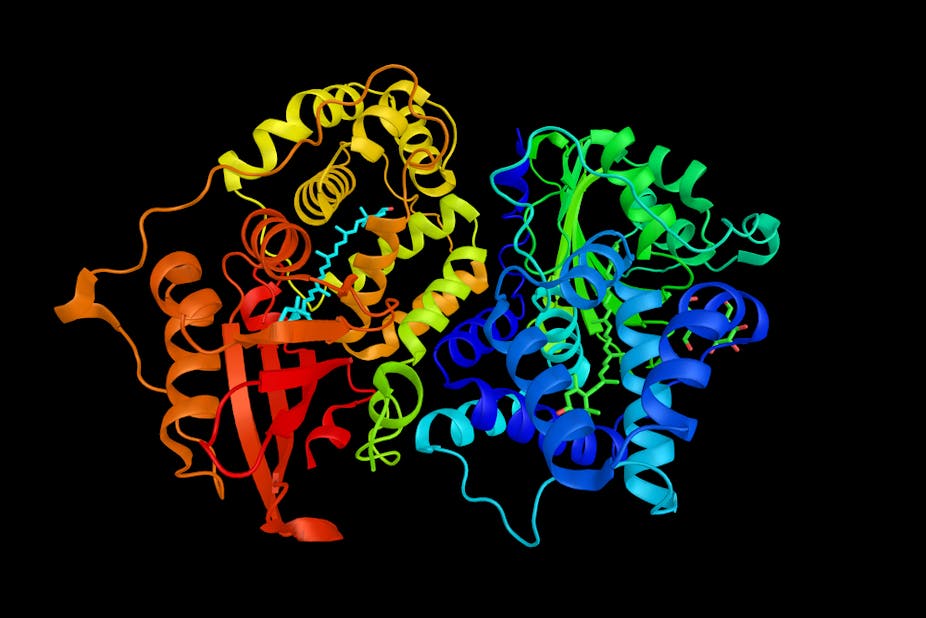People have always been fascinated by life. We dream about revealing all its mysteries and are even searching other planets trying to find some forms of life there. Philosophies around the world have tried to define and understand life long before science even existed. But some of the answers may actually be found right under our noses – or rather, right under a microscope.
That’s because an entire world exists at the bio-molecular level. Without it, life as we know and understand it wouldn’t exist.
Proteins are among the key players in this bio-molecular world. They do their job by binding to each other or to other molecules to achieve their genetically pre-programmed goals. For instance, a protein complex called haemoglobin delivers oxygen to every cell of our bodies to perform respiration. Almost every action involves an interaction between protein complexes.
The aim of our work was to uncover a very fundamental detail of life at the bio-molecular level. For the first time, we were able to describe at a detailed level how two proteins, as they exist in nature, interact with each other and how they behave in their own molecular worlds.
It’s no easy task to actually watch life at the molecular level, and to see individual proteins at work. We managed to do this using a technique called single molecule spectroscopy, which allows scientists to investigate the properties of individual molecules.
Single proteins at work
Under the spectroscope, we explored a unique biochemical system that protects photosynthetic bio-molecular machinery – and the whole organism – from lethal levels of the sun, for example on a cloudless day at noon.
Photosynthesis is a complex, potentially dangerous process: photosynthetic organisms can die when exposed to too much light. This may sound odd, given that such organisms need light to survive. But it’s an excellent example of how too much of a good thing can turn bad. This is why photosynthetic organisms have photoprotective mechanisms, which shield them from too much light.
These mechanisms use various proteins to regulate the amount of energy flowing through the photosynthetic apparatus.
In these systems, it’s the interactions between some proteins that determine whether an organism will survive under the full sun or not. And while these systems do the same job – removing the excessive energy from the photosynthetic apparatus in a safe way – they work differently in different organisms.
Our latest work allowed us to see how one of these photoprotective mechanisms operates. We studied at an incredible level of detail, one at a time, the protein “antennae” that are responsible for the harvesting of light. Doing so led to an important discovery.
We already knew that the main photoprotective mechanism in cyanobacteria involves the binding of a protein called orange carotenoid protein onto the photosynthetic light-harvesting “antenna”. This work also revealed that the binding is a complex process which involves an intermediate step.
A simple model
A simple experiment helps to explain this process and the crucial intermediate step.
Imagine a staircase built from a few toy bricks with a small container placed below the lowest stair. Take the whole system out in the rain – and watch how water is collected on the stairs, then goes down until it finally falls into the container.
In our experiment, the rain represents the sunlight and the staircase works conceptually like a photosynthetic antenna. The water is collected on the stairs in the same way solar energy is in the photosynthetic antennae. The energy remains in the antenna until reaching the so-called reaction centre, where the light energy is converted into a more stable form of energy.
Because the staircase is made out of bricks, it’s not waterproof. It leaks: the water drips on the floor at different places instead of reaching the container. In the same way, the photosynthetic antennae leaks a small fraction of energy.
By observing these “leakages” using spectroscopy, we have learned about the intricate details of the photosynthetic process.
In heavy rainfall, too much water would go down your stairs and overflow the container. The equivalent situation – intense rays of sunlight – is potentially deadly for photosynthetic organisms; they must work hard to avoid this. That’s where photoprotective mechanisms come in.
The mechanisms we studied work as if they were collecting water from the stairs and safely removing it before it reaches the container. In cyanobacteria’s photosynthetic apparatus, orange carotenoid protein acts as the “collector”. Our work shows how this protein is inserted into the photosynthetic apparatus to get rid of harmful, excess absorbed light energy.
For this insertion to happen, part of the cyanobacteria’s antenna system actually detaches for a short time. This allows the orange carotenoid protein to “dock”: it binds tightly to the antenna so it can start to effectively remove dangerous excess energy. This step was completely unknown and could only have been accessed using single molecule spectroscopy.
New knowledge
This new knowledge helps us to understand and appreciate how complicated life is even at the basic bio-molecular level. Advanced experimental methods like single molecule spectroscopy bring this mysterious world of bio-molecules closer to us and show how important it is for the functioning of organisms on Earth.

